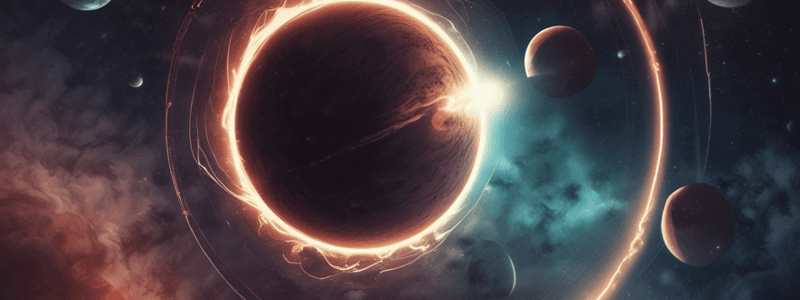Podcast
Questions and Answers
What condition is necessary for a lunar eclipse to occur?
What condition is necessary for a lunar eclipse to occur?
- The Earth's rotation must synchronize with the Moon's rotation
- The Moon must be in its first or last quarter phase
- The Moon must pass through the plane of Earth's orbit (correct)
- The Earth and Moon must be at perigee
What is the 'line of nodes' in the context of lunar and solar eclipses?
What is the 'line of nodes' in the context of lunar and solar eclipses?
- The line on Earth's surface directly under the Moon
- The line that represents the Moon's path around the Earth
- The imaginary line that connects the two nodes of the Moon's orbit around Earth (correct)
- The imaginary line connecting the Earth and the Moon
During which phases of the Moon are eclipses possible?
During which phases of the Moon are eclipses possible?
- New and full phases (correct)
- First and last quarter phases
- Gibbous and waning gibbous phases
- Waxing crescent and waning crescent phases
What causes the precession of the Moon's orbit?
What causes the precession of the Moon's orbit?
Approximately how long does each eclipse season last?
Approximately how long does each eclipse season last?
What key aspect of the Saros cycle complicates the prediction of eclipse locations?
What key aspect of the Saros cycle complicates the prediction of eclipse locations?
How often do eclipse seasons occur?
How often do eclipse seasons occur?
How long does it take for the line of nodes to make one full rotation due to precession?
How long does it take for the line of nodes to make one full rotation due to precession?
When does a lunar eclipse occur?
When does a lunar eclipse occur?
Why don't we see an eclipse at every full moon or new moon?
Why don't we see an eclipse at every full moon or new moon?
What is the arrangement of the Sun, Moon, and Earth during a new moon?
What is the arrangement of the Sun, Moon, and Earth during a new moon?
In which condition will the moon appear fully illuminated from Earth?
In which condition will the moon appear fully illuminated from Earth?
In the example of using a hand in a dark room to demonstrate moon phases, what does the new moon represent?
In the example of using a hand in a dark room to demonstrate moon phases, what does the new moon represent?
How can one predict an eclipse without sophisticated equipment?
How can one predict an eclipse without sophisticated equipment?
What causes the shadows during most full moons or new moons to miss the Moon or Earth?
What causes the shadows during most full moons or new moons to miss the Moon or Earth?
Flashcards are hidden until you start studying
Study Notes
Lunar and Solar Eclipses
- An eclipse occurs when the Moon is in Earth's shadow or the Sun is blocked by the Moon, and can only happen during a full moon or a new moon.
Types of Eclipses
- A lunar eclipse occurs during a full moon, when the Earth is between the Sun and the Moon, casting a shadow on the Moon.
- A solar eclipse occurs during a new moon, when the Moon is between the Sun and the Earth, blocking the Sun's light.
Orbits and Nodes
- The Moon's orbit is inclined by a few degrees to the Earth's orbital plane, which is why eclipses don't occur every full moon or new moon.
- The points where the Moon's orbit passes through the plane of Earth's orbit are called nodes.
- The imaginary line that connects the two nodes of the Moon's orbit around Earth is called the line of nodes.
- Eclipses can only occur when the Moon passes through the plane of Earth's orbit, which is when the line of nodes points towards the Sun.
Eclipse Season
- The line of nodes points at the Sun during the eclipse seasons, which are the times when eclipses of the Moon and Sun are possible.
- Eclipse seasons last for about a month and occur every six months, but do not occur at the same time every year due to the Moon's orbit precessing.
The Saros Cycle
- The Saros cycle is an 18 year, 11 and one-third day cycle and pattern of solar and lunar eclipses.
- The pattern of eclipses repeats in a cyclical manner because the Moon, nodes, and Sun return to the same arrangement as when the Saros first began.
- The Saros cycle can be used to predict future eclipses, so long as records and dates of previous eclipses are available.
Studying That Suits You
Use AI to generate personalized quizzes and flashcards to suit your learning preferences.




